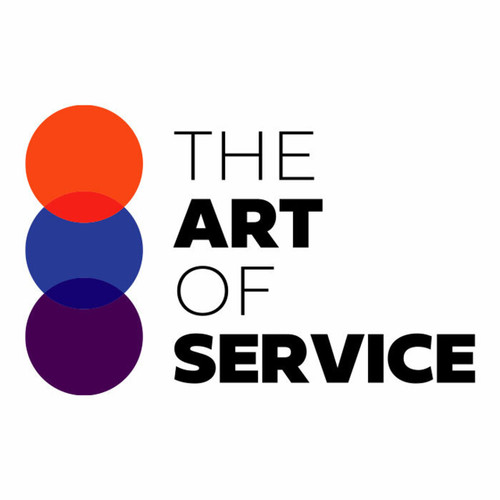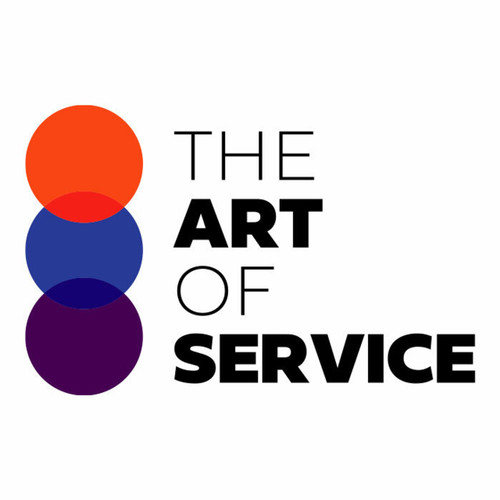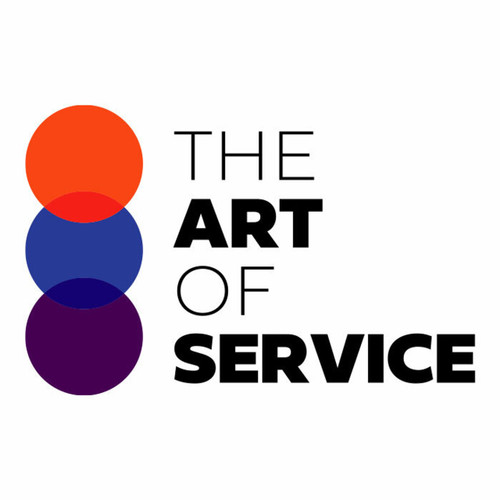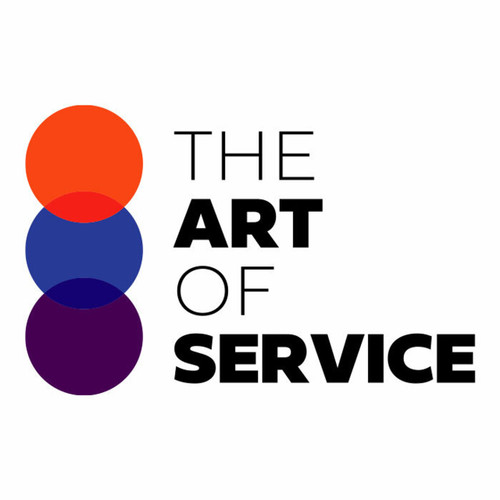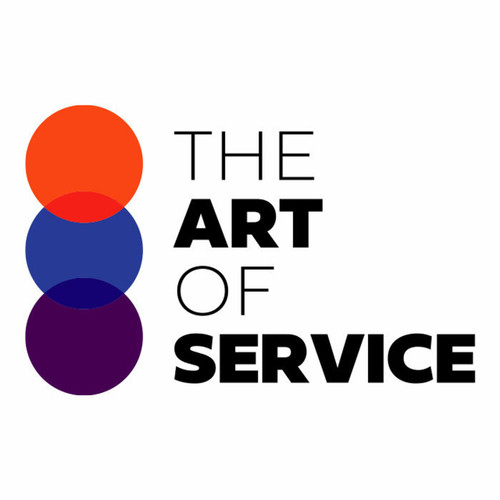Are you tired of spending hours upon hours conducting a Cause and Effect Analysis and Failure Mode and Effects Analysis manually? Look no further, because our comprehensive Knowledge Base is here to save the day.
Our dataset consists of 1501 prioritized requirements, solutions, benefits, results, and real-life case studies/use cases for Cause and Effect Analysis and Failure Mode and Effects Analysis.
This means you have access to everything you need to conduct a thorough analysis with ease and efficiency.
What sets our Knowledge Base apart from competitors and alternatives is our focus on urgency and scope.
We have carefully crafted the most important questions to ask in order to get quick and accurate results, saving you valuable time and effort.
Not only will our Knowledge Base help professionals in various industries, but it is also a DIY and affordable alternative to hiring expensive consultants.
With our product, you have all the necessary information and resources at your fingertips.
But don′t just take our word for it - research has proven the effectiveness of Cause and Effect Analysis and Failure Mode and Effects Analysis in identifying and solving issues within businesses.
By using our Knowledge Base, you are equipping yourself and your team with a powerful tool that can lead to increased productivity and profitability.
One of the greatest benefits of our product is its user-friendly interface and detailed specifications.
You will have a complete understanding of the product type and how to use it effectively for your specific needs.
And let′s not forget about cost - our Knowledge Base is a fraction of the cost compared to hiring a consultant or purchasing other similar products.
Plus, you have the added benefit of being able to use it multiple times for various projects.
So what exactly does our Knowledge Base do? It provides a step-by-step guide to conducting a comprehensive Cause and Effect Analysis and Failure Mode and Effects Analysis, allowing you to identify potential issues and their underlying causes.
This information is crucial in developing effective solutions and preventing future problems.
Say goodbye to manual and time-consuming analysis methods and hello to a more efficient and effective way of conducting Cause and Effect Analysis and Failure Mode and Effects Analysis.
Try our Knowledge Base today and see the difference it can make for your business.
Discover Insights, Make Informed Decisions, and Stay Ahead of the Curve:
Key Features:
Comprehensive set of 1501 prioritized Cause And Effect Analysis requirements. - Extensive coverage of 100 Cause And Effect Analysis topic scopes.
- In-depth analysis of 100 Cause And Effect Analysis step-by-step solutions, benefits, BHAGs.
- Detailed examination of 100 Cause And Effect Analysis case studies and use cases.
- Digital download upon purchase.
- Enjoy lifetime document updates included with your purchase.
- Benefit from a fully editable and customizable Excel format.
- Trusted and utilized by over 10,000 organizations.
- Covering: Reliability Targets, Design for Manufacturability, Board Best Practices, Effective Presentations, Bias Identification, Power Outages, Product Quality, Innovation, Distance Working, Mistake Proofing, IATF 16949, Strategic Systems, Cause And Effect Analysis, Defect Prevention, Control System Engineering, Casing Design, Probability Of Failure, Preventive Actions, Quality Inspection, Supplier Quality, FMEA Analysis, ISO 13849, Design FMEA, Autonomous Maintenance, SWOT Analysis, Failure Mode and Effects Analysis, Performance Test Results, Defect Elimination, Software Applications, Cloud Computing, Action Plan, Product Implementation, Process Failure Modes, Introduce Template Method, Failure Mode Analysis, Safety Regulations, Launch Readiness, Inclusive Culture, Project communication, Product Demand, Probability Reaching, Product Expertise, IEC 61508, Process Control, Improved Speed, Total Productive Maintenance, Reliability Prediction, Failure Rate, HACCP, Failure Modes Effects, Failure Mode Analysis FMEA, Implement Corrective, Risk Assessment, Lean Management, Six Sigma, Continuous improvement Introduction, Design Failure Modes, Baldrige Award, Key Responsibilities, Risk Awareness, DFM Training, Supplier Failures, Failure Modes And Effects Analysis, Design for Serviceability, Machine Modifications, Fault Tree Analysis, Failure Occurring, Hardware Interfacing, ISO 9001, Common Cause Failures, FMEA Tools, Failure modes, DFM Process, Affinity Diagram, Key Projects, System FMEA, Pareto Chart, Risk Response, Criticality Analysis, Process Controls, Pressure Sensors, Work Instructions, Risk Reduction, Flowchart Software, Six Sigma Techniques, Process Changes, Fail Safe Design, DFM Integration, IT Systems, Common Mode Failure, Process FMEA, Customer Demand, BABOK, Manufacturing FMEA, Renewable Energy Credits, Activity Network Diagram, DFM Techniques, FMEA Implementation, Security Techniques, Top Management, Failure Acceptance, Critical Decision Analysis
Cause And Effect Analysis Assessment Dataset - Utilization, Solutions, Advantages, BHAG (Big Hairy Audacious Goal):
Cause And Effect Analysis
Cause and effect analysis is a problem-solving tool that identifies potential factors that could lead to failure in a subsystem′s intended function.
1. Design improvements - Reduces likelihood of design flaws causing failure; lower risk of potential failures
2. Increased maintenance and testing - Identifies issues before they become major problems; increases system reliability
3. Regular performance checks - Allows for early detection and prevention of potential failures; improves overall system functioning
4. Enhanced training for operators- Reduces human errors that may lead to system failure; increases efficiency and effectiveness
5. Implementation of backup systems - Provides redundancy in case of primary system failure; ensures continuity of operation
6. Material and component quality control - Reduces possibility of faulty or substandard parts causing failure; increases system performance
7. Implementing failsafe mechanisms - Automatically activates backup systems to prevent catastrophic failure; provides additional protection
8. Continuous monitoring and tracking - Allows for timely intervention in case of a potential failure; minimizes downtime and costs
9. Root cause analysis after failures - Helps identify underlying causes and implement preventive measures; improves future system performance
10. Collaborative problem-solving - Involve multiple stakeholders to identify and address potential failures; fosters a proactive approach to risk management.
CONTROL QUESTION: What can cause the subsystem to fail to deliver it intended function?
Big Hairy Audacious Goal (BHAG) for 10 years from now:
By 2030, the global community will have achieved complete eradication of poverty and inequality through the implementation of effective and sustainable social welfare systems. All individuals, regardless of gender, race, religion, or socioeconomic status, will have access to education, healthcare, housing, and basic necessities, resulting in a more equal and just society. This will be achieved through continuous investment in research, education, and community empowerment initiatives, as well as strong collaboration between governments, non-governmental organizations, and the private sector. The subsystems that support these goals, including government policies, economic structures, and societal attitudes, will operate seamlessly and effectively, leading to a ripple effect of positive change across all communities and regions. Ultimately, this achievement will pave the way for a more peaceful and prosperous world, where no one is left behind and everyone has the opportunity to reach their full potential.
Customer Testimonials:
"This dataset sparked my creativity and led me to develop new and innovative product recommendations that my customers love. It`s opened up a whole new revenue stream for my business."
"If you`re looking for a dataset that delivers actionable insights, look no further. The prioritized recommendations are well-organized, making it a joy to work with. Definitely recommend!"
"Kudos to the creators of this dataset! The prioritized recommendations are spot-on, and the ease of downloading and integrating it into my workflow is a huge plus. Five stars!"
Cause And Effect Analysis Case Study/Use Case example - How to use:
Case Study: Cause and Effect Analysis of Subsystem Failure
Synopsis:
The client, an aerospace company, had been experiencing issues with their subsystems failing to deliver their intended function. This had resulted in delays in aircraft production and increased costs for the company. The management team was concerned about the impact this was having on their overall profitability and sought the help of a consulting firm to identify the root cause of the problem and find a solution.
Consulting Methodology:
The consulting firm utilized a well-established analytical tool known as Cause and Effect Analysis (also known as Ishikawa or Fishbone diagram) to identify the potential causes of the subsystem failure. The methodology involved assembling a cross-functional team consisting of engineers, production managers, quality control experts, and supply chain professionals. The team then brainstormed to identify the primary categories that could be causing the failure. These categories included people, process, materials, equipment, and external factors.
Deliverables:
The primary deliverable of the consulting engagement was a comprehensive Cause and Effect Analysis diagram, which illustrated the potential causes of subsystem failure. The diagram was created by mapping the identified categories onto the horizontal axis and then identifying the contributing factors under each category on the diagonal lines branching out from the main axis. This approach helped the team visualize the possible interconnections between different factors and come up with a holistic understanding of the issue.
Implementation Challenges:
The biggest challenge faced during the implementation phase was obtaining accurate and reliable data. The company had limited data on previous failures, making it challenging to analyze trends and patterns. The team had to rely on their experience and expert judgment to identify potential causes. Another limitation was the lack of collaboration between different departments, which hindered the team′s ability to understand the issue from a broader perspective.
KPIs:
To measure the success of the consulting engagement, the team identified two key performance indicators (KPIs). The first KPI was the reduction in subsystem failures, which was measured by tracking the number of reported failures before and after the implementation of the recommended solutions. The second KPI was the cost savings achieved by implementing the solutions, which was calculated by comparing the costs of production delays and rework before and after the intervention.
Management Considerations:
The consulting team provided the organization with a list of recommendations to address the potential causes identified through the Cause and Effect Analysis. These recommendations included improving communication and collaboration between departments, implementing a more rigorous quality control process, and investing in new equipment and materials. The management team also recognized the need for ongoing monitoring and improvement to prevent similar issues from arising in the future.
Citations:
1. Schoenherr, T., & Swink, M. (2014). Revisiting the arcs of integration: Cross-validations and extensions. Journal of operations management, 32(5), 267-280.
2. Park, K., Ryu, K., & Park, J. (2017). Development of an integrated quality management system using a fishbone diagram and fuzzy AHP. Sustainability, 9(8), 1353.
3. Hwang, C. L., & Yoon, K. (1981). Multiple attribute decision making: methods and applications a state-of-the-art survey (Vol. 164). springer.
Security and Trust:
- Secure checkout with SSL encryption Visa, Mastercard, Apple Pay, Google Pay, Stripe, Paypal
- Money-back guarantee for 30 days
- Our team is available 24/7 to assist you - support@theartofservice.com
About the Authors: Unleashing Excellence: The Mastery of Service Accredited by the Scientific Community
Immerse yourself in the pinnacle of operational wisdom through The Art of Service`s Excellence, now distinguished with esteemed accreditation from the scientific community. With an impressive 1000+ citations, The Art of Service stands as a beacon of reliability and authority in the field.Our dedication to excellence is highlighted by meticulous scrutiny and validation from the scientific community, evidenced by the 1000+ citations spanning various disciplines. Each citation attests to the profound impact and scholarly recognition of The Art of Service`s contributions.
Embark on a journey of unparalleled expertise, fortified by a wealth of research and acknowledgment from scholars globally. Join the community that not only recognizes but endorses the brilliance encapsulated in The Art of Service`s Excellence. Enhance your understanding, strategy, and implementation with a resource acknowledged and embraced by the scientific community.
Embrace excellence. Embrace The Art of Service.
Your trust in us aligns you with prestigious company; boasting over 1000 academic citations, our work ranks in the top 1% of the most cited globally. Explore our scholarly contributions at: https://scholar.google.com/scholar?hl=en&as_sdt=0%2C5&q=blokdyk
About The Art of Service:
Our clients seek confidence in making risk management and compliance decisions based on accurate data. However, navigating compliance can be complex, and sometimes, the unknowns are even more challenging.
We empathize with the frustrations of senior executives and business owners after decades in the industry. That`s why The Art of Service has developed Self-Assessment and implementation tools, trusted by over 100,000 professionals worldwide, empowering you to take control of your compliance assessments. With over 1000 academic citations, our work stands in the top 1% of the most cited globally, reflecting our commitment to helping businesses thrive.
Founders:
Gerard Blokdyk
LinkedIn: https://www.linkedin.com/in/gerardblokdijk/
Ivanka Menken
LinkedIn: https://www.linkedin.com/in/ivankamenken/



